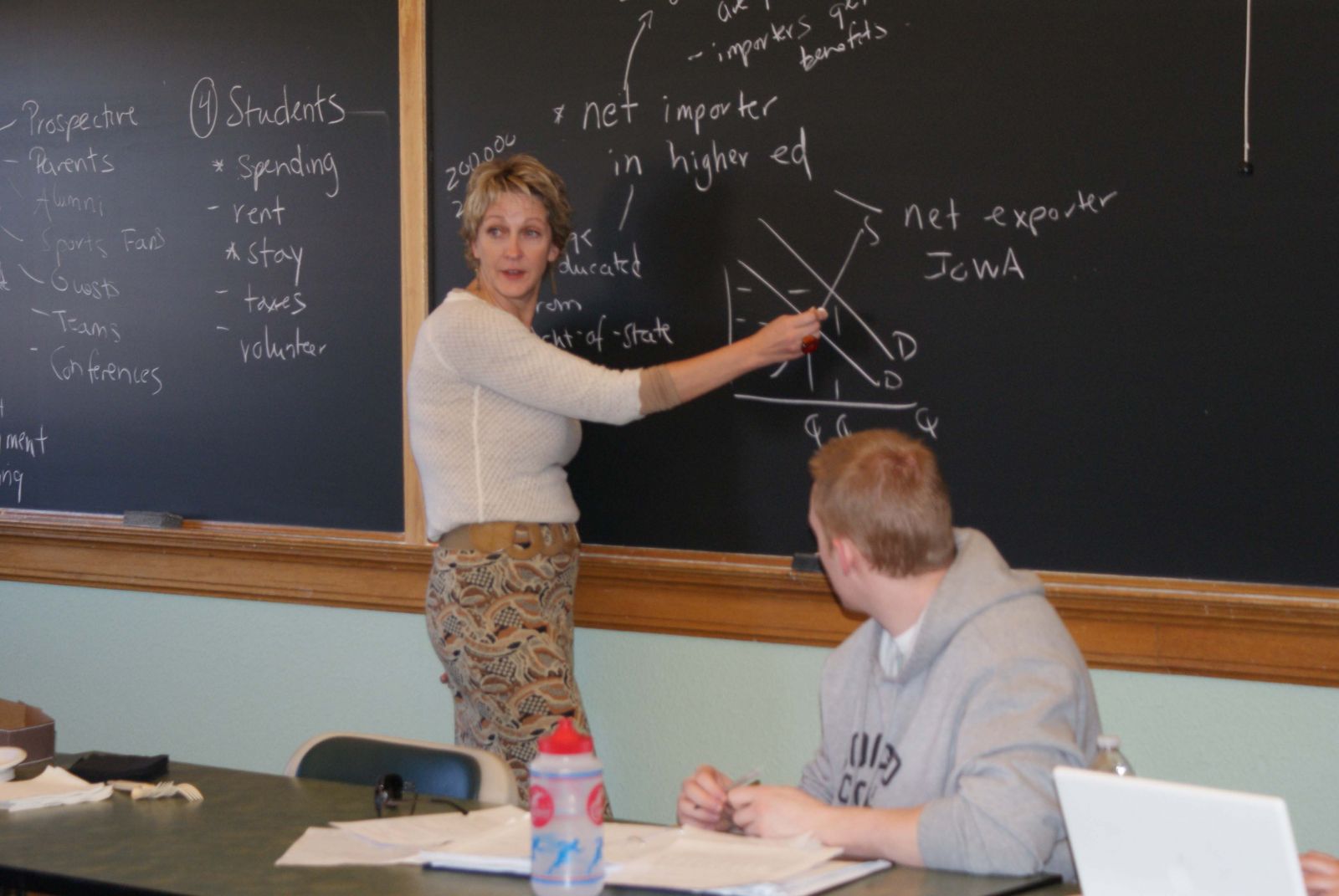You have /5 articles left.
Sign up for a free account or log in.
Jill Tiefenthaler’s class at Colorado College on the economics of higher education is a chance for students to develop not only a better understanding of some of the major issues confronting higher education, but also to learn a little bit more about their own institution.
Learning more about the college was why Tiefenthaler wanted to teach the class in the first place. Tiefenthaler, who became the college’s president in July after serving as provost at Wake Forest University, is well-versed is the economic challenges facing higher education and institutions like Colorado College. But she wanted to teach the class as her own introduction to Colorado’s unique block schedule, in which students take one class at a time for three and a half weeks -- a total of four classes per semester.
“I felt that it was important for me to teach – here in particular – because the block system is very different, and teaching would give me a good sense of what faculty members do during the semester,” Tiefenthaler said.
So for part of January and February, Tiefenthaler, her co-teacher and husband Kevin Rask, and a group of 12 students wrestled with some of the issues Tiefenthaler considers on a daily basis – from why education costs so much to the roles boards and faculty should play in governing an institution – while also helping the new professors get acclimated to the schedule.
Teaching What You Know
Tiefenthaler and Rask, who met in graduate school at Duke University, have worked together in the past. Both are economists by training, and while Tiefenthaler started getting involved in big-picture higher education issues as an administrator, Rask started using institutional examples in his classes to make econometrics more relatable to students.
They taught a class on the economics of higher education when they were at Wake Forest, but when they decided to teach it at Colorado, they had to rework the syllabus to fit the block schedule. They also tried to make better use of the unique structure and resources at their disposal, including field trips to local higher education institutions such as the University of Colorado at Colorado Springs and state government offices.
Rask and Tiefenthaler said there’s a back-and-forth between them about what they should teach based on their own interests. Rask, who describes himself as “a faculty brat” who grew up at Ohio State University, enjoys teaching about individual choice issues, such as admissions, financial aid, why students choose majors, and how those choices relate to earnings after graduation. Tiefenthaler, the administrator, likes teaching the broad, institutional issues, such as the future of the research university model and the for-profit sector and how its changing higher education. “There’s this pull back and forth between us,” Rask said. “It makes us good complements.”
The point of the class, Rask and Tiefenthaler said, is to teach econometrics through the lens of higher education. About half the readings deal with current issues and half of them are from economics journals. Most classes are discussions, with some lectures on the more difficult material. Tiefenthaler said she has had to mix up pedagogical models to keep student engaged during the two-and-a-half-hour block.
The syllabus touches on many of the issues that have been in the news recently. One of the major readings is Why Does College Cost So Much? by Robert B. Archibald and David H. Feldman, two economics professors at the College of William and Mary, which Tiefenthaler also assigned to her governing board. Students also learned about the economic benefits for getting a degree, the disputes in Texas about measuring the productivity of public university faculty members, and the decrease in state support for public institutions.
For the most part, Colorado College doesn’t have to worry about many of the economic issues facing many other colleges and universities. The university has a stable economic outlook with high demand – it had its most applications ever for this fall’s class – and a fairly large endowment. It is a liberal arts college in a part of the country known for large public universities, giving the college a clear niche. But Tiefenthaler said class discussions have hit at issues Colorado faces. The rate at which alumni give to the college is lower than those of many of Colorado’s peer institutions. One of the class readings noted that alumni who live close to an institution tend to give more and give more often. Given Colorado's distance from many population centers, that's not a benefit the college has. “At Colorado College, 60 percent of our alumni live more than 1,000 miles from us,” Tiefenthaler said. “We have to figure out a way to keep engaging them even if they are far away.”
Tiefenthaler brought a trustee into class one day to discuss with students what about the institution they would like to see change. “He didn’t want ‘We don’t like the food,’ he wanted big-picture,” said Joey Wolf, a senior in the class. “For the most part we’re happy with the school, but we did come up with a few solutions.”
Aside from the issues the class tackled together, each student had to write a final paper that was an econometric study on some higher education topic of their choosing. Laura Putnam, a senior mathematical economics major from Vermont, wrote hers on major selection to coincide with a thesis she’s working on. Wolf tried to estimate how much revenue an NFL-caliber college football player brought to a university. On Tuesday night he was just wrapping up his analysis, which had to be turned in the next day.
 Professor President
Professor President
Several college and university presidents teach classes during their presidencies, and their commitment to the classroom varies. Some might teach a full class or only one day a week, while others might pop in and out of a class co-taught with another professor.
The commitment was slightly different for Tiefenthaler. Because of the block plan, she had to block out much of her day for three and a half weeks. She rescheduled travel and meetings to make sure she could be around campus for the two-and-a-half-hour block.
Teaching the class was important to Tiefenthaler, not just to help her understand the block schedule, but also to better understand student culture at Colorado. “When I’ve been an administrator, it has helped connect me to the mission,” she said. “It’s easy to forget about what we do here, and when you teach you get that opportunity, you get at the core of the college’s mission. You get to know the students in a way that you can only know them when you’re teaching. I sometimes see students at events, dinners, and at office hours, but when you teach them in a class you get to know them intellectually, which helps you get a sense of the school.”
Because Tiefenthaler has presidential obligations to fulfill, Rask handles many of the out-of-class duties, such as office hours. But students in the class noted that, when they had questions for Tiefenthaler, she replied promptly to e-mails.
Rask said he noticed a difference between teaching with his wife when she was a provost and teaching with her now that she’s president. “Most students didn’t know what a provost is,” he said. With the president in the class, there was a little bit more formality. “During the first few classes with her in it, I don’t think they were quite sure how to deal with her,” Rask said. “But by the end of the first week they were pretty normal with her.” Colorado College classes are fairly informal, Tiefenthaler, Rask, and students said. Students and professors call each other by their first names both in and out of the classroom. “It wasn’t Professor Tiefenthaler or President Tiefenthaler, it was Jill,” Wolf said.
A Culture of Engagement
The class was designed for upper-level students who have already taken some economics courses, and many of the students are economics majors. By the time Tiefenthaler decided to offer the class, students had already finalized their schedules, so the students had to drop a class to pick up the president's.
Some students said it was the subject matter that interested them more than the fact that the president was teaching it, but the latter was a nice perk. Putnam said she had already been interested in some of the issues the class would tackle. She’s writing her senior thesis on how students choose their majors and whether economic factors play into that decision. “The fact that there was a class about what my thesis was about and that it was being taught by the president, of course I’m taking that class,” she said.
Wolf, who said he is already done with the requirements for his economics major, said having Tiefenthaler in the classroom was a big draw. "If she wasn't teaching it, I'm not sure I would have taken it," he said. "I had never met her, and this was a great opportunity to do that. I didn't know if she'd ever offer this again."
Rask and Tiefenthaler both said they have a better understanding of the culture of Colorado College after teaching. Both said they see a level of engagement in Colorado students that they haven’t seen elsewhere, which they attributed both to the academic rigor of the college and the block plan. “For those three and a half weeks you own each other,” Rask said. “Besides extracurricular activities, they are just doing your stuff.” He said that after class in the morning, a much higher percentage of students will regularly come back to the economics building to discuss issues with him than he’s seen at other institutions.
And the class was as much a learning experience for the instructors. Tiefenthaler said she has a better understanding of what both faculty members and students go through during a teaching block, as well how that shapes the culture of Colorado College.
“I think we were three or four days in, and Jill said, ‘This is going so fast; are you guys keeping up with pace of the readings?’ ” Wolf said. “We just nodded our heads. Here we were getting the president used to block plan. It was a funny moment.”








